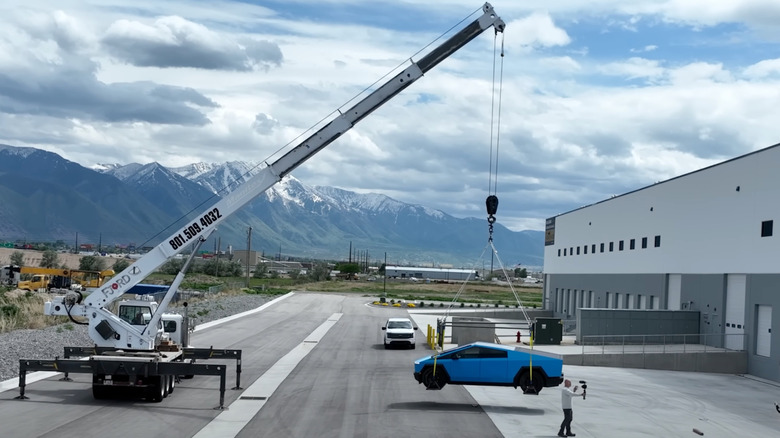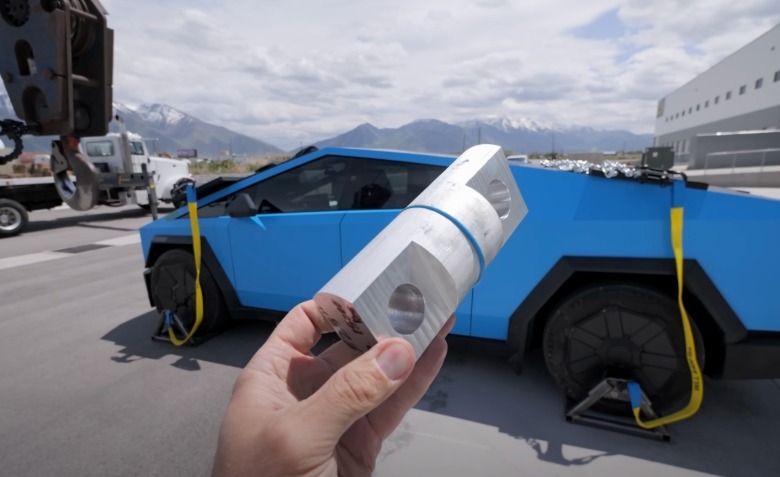
The Tesla Cybertruck has taken its fair share of flak — from depreciation to body panels falling off. Now it's going viral again for something entirely unexpected: being held mid-air by glue. In a recent YouTube video by JerryRigEverything, the wedge of stainless steel and fragile egos is seen dangling off the ground suspended from a crane. The only thing hold up the $100,000 truck was a two-and-a-half-inch patch of Tesla structural adhesive between the crane's hook and the 6,600-pound vehicle.

This
stunt followed a legitimate concern of Jerry's around Tesla's structural repair method. Months earlier, the same truck suffered what looked like a catastrophic failure when its tow hitch ripped clean out of the rear casting during a stress test that pushed far beyond its rated 1,100-pound tongue weight. Instead of getting totaled, the truck was repaired using Tesla's published repair procedure: sectioning out the broken gigacasting and gluing in a replacement section using a structural adhesive called Fusor 2098.
After curing, this specific repair adhesive has a tensile strength of 3,190 pounds per square inch (psi). A two-and-a-half-inch patch of the same blue glue used in that repair bore the entire weight of the Cybertruck. You read that right — glued, cured, then hoisted skyward. Whether you see that as genius or terrifying probably depends on how much time you've spent in collision shops. Either way, it's an impressive demonstration.
Read more: 2025 Cadillac Escalade IQ Is All About Big Numbers
Cool Stunt, But What This Means For Modern Car Repair
The idea of glue holding your car together feels a little unsettling — like duct tape on a spaceship. But in today's auto engineering, it's not just common, but in many cases, it's the smarter, stronger choice. The adhesive used in the Cybertruck repair is a two-part epoxy classified as a Crash Durable Structural Adhesive. It's not Tesla-exclusive, either — all OEMs use similar stuff for high-strength bonding across differing substrates.
Why not just weld it? Well, adhesives in some applications distribute loads more evenly, preserve material integrity, and protect against corrosion between joints. Plus, when paired with mechanical fasteners like rivets — which Tesla also specifies for this repair — the resulting bond can outperform welds in peel and impact strength.
But there's a flip side: if your ride needs this kind of fix, it better be done exactly by the book. Adhesives can be uber-strong, but that doesn't mean it can, or should, be used in lieu of OEM repair procedures. Tesla mandates that only certified shops use specified adhesives, parts, and procedures. No aftermarket shortcuts, no recycled structures, and absolutely no expired glue. Every step — from grinding off etch-coat, to rivet type and spacing, to adhesive bead thickness — all laid out in the repair manuals.
Here's where things get murky, though. If you're in a wreck, your insurance policy promises to return your car to its "pre-loss condition." But what does that even mean when you're gluing in structural chunks that were once a monolithic piece? Is a sectioned-then-epoxied casting still "as it was"? Tesla says yes — the repair is OEM-approved. Technically speaking, it should meet or exceed original specs — but that's assuming the job's done right. Honestly, we'd love to see JerryRigEverything run that hitch test again on the repaired Cybertruck. If the glue job really is stronger than stock, that truck should out-muscle its factory self.
Want more like this? Join the Jalopnik newsletter to get the latest auto news sent straight to your inbox...
Read the original article on Jalopnik.











